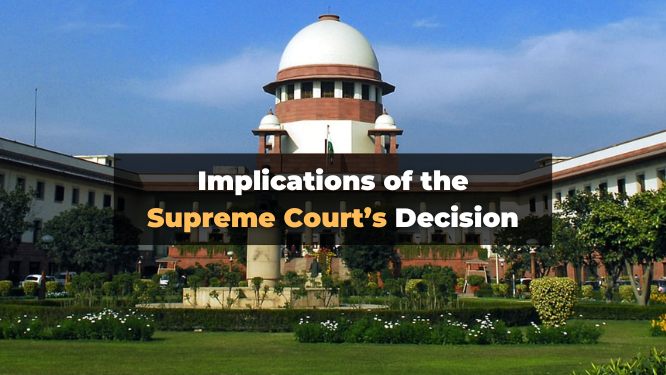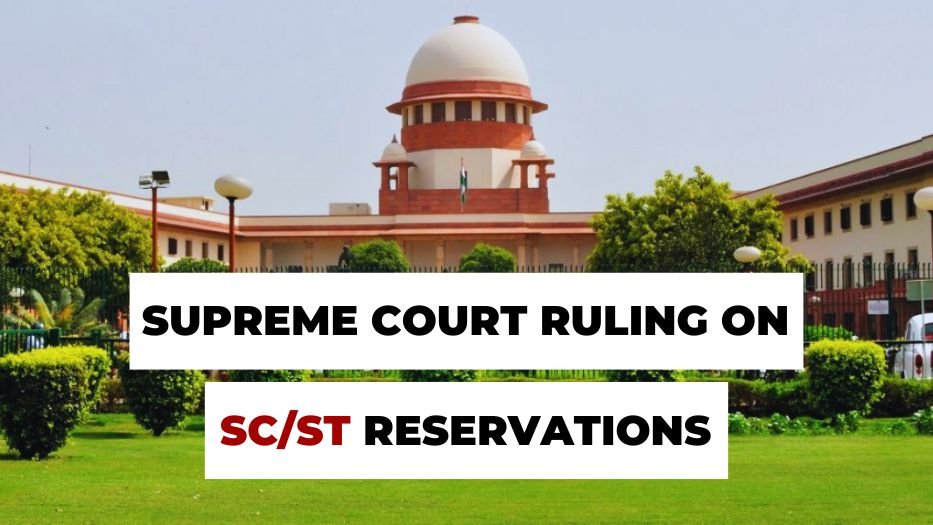Supreme Court Ruling on SC/ST Reservations: Key Impacts and Legal Insights
Introduction
Reservation, or affirmative action, is a policy designed to provide social justice and equality to historically marginalized communities in India. It has been a subject of intense debate, with proponents and opponents voicing their opinions passionately. The issue has also been a political hot potato, with various parties using it to their advantage. The Indian judiciary, particularly the Supreme Court, has often been called upon to interpret and provide clarity on reservation policies.
Recently, a landmark decision was made by a seven-judge Constitutional Bench of the Supreme Court regarding SC/ST reservations. This decision has far-reaching implications, and in this blog post, we will delve deep into its details, analyzing its impact on SC/ST quotas and the general population.
The Supreme Court’s Constitutional Bench: An Overview
The Supreme Court’s seven-judge bench, led by Chief Justice DY Chandrachud, included Justices Manoj Mishra, BR Gavai, Pankaj Mithal, Vikram Nath, Satish Chandra Sharma, and Bela Trivedi. The bench delivered a significant ruling on the constitutionality of the SC/ST reservation system. The decision was made with a 6:1 majority, reflecting the complexity and sensitivity of the issue at hand.
Key Takeaways from the Supreme Court’s Decision
- SC/ST Reservation is Constitutional: The bench reaffirmed that reservation for SC/ST communities is constitutional. This decision was supported by Chief Justice Chandrachud and Justices Mishra, Gavai, Mithal, Nath, and Sharma. However, Justice Bela Trivedi dissented, arguing that the reservation system as it stands is unconstitutional.
- Introduction of the Creamy Layer Principle: A significant aspect of the decision was the introduction of the creamy layer concept within the SC/ST reservation system. The creamy layer principle, which was previously applied only to OBC reservations, allows for the exclusion of the more privileged sections of a backward class from availing of the benefits of reservation. Justice Gavai and others on the bench supported the application of this principle to SC/STs, with Justice Trivedi dissenting.
- Limiting Reservation to One Generation: Another critical aspect of the decision was the debate over whether reservation benefits should be limited to one generation within a family. Justice Pankaj Mithal supported the idea that if one generation of a family has benefited from reservation, the next generation should not be entitled to the same benefits. This view, however, was not universally accepted by all the judges.
For personalized legal advice on how this ruling might affect you or your business, reach out at +91 9990539100 or visit www.notguiltylawoffices.com. We are here to help you navigate these complex legal landscapes.
Implications of the Supreme Court’s Decision

The Supreme Court’s ruling has several significant implications:
- Impact on SC/ST Communities: The decision has opened the door for state governments to apply the creamy layer principle to SC/ST reservations. This means that within the SC/ST communities, those who have achieved a certain level of economic or social advancement may no longer be eligible for reservation benefits. The aim is to ensure that the benefits of reservation reach those who are truly in need.
- State Government’s Role: The ruling gives state governments the authority to determine how to implement the creamy layer principle within SC/ST reservations. This could lead to a diverse application of the law across different states, depending on their socio-political contexts.
- Impact on Future Generations: If the idea of limiting reservation benefits to one generation is widely adopted, it could lead to a significant shift in how reservations are applied. This would prevent families from continuously benefiting from reservations across generations, potentially leading to a more equitable distribution of opportunities.
Reservation Within Reservation: The Historical Context
The concept of reservation within reservation, or sub-categorization, is not entirely new. It has been attempted in the past, with varying degrees of success and legal challenges:
- Punjab’s 2006 Law: In 2006, Punjab enacted a law that sought to reserve 25% of government jobs for SCs and 12% for OBCs. Furthermore, it attempted to allocate 50% of the SC reservation to the Valmiki and Mazhabi Sikh communities. However, this law was struck down as unconstitutional by the Punjab and Haryana High Court in 2010.
- Andhra Pradesh’s Attempt: In Andhra Pradesh, a similar effort was made to sub-categorize SCs and provide 15% reservation to certain sub-castes. This too was declared unconstitutional by the Supreme Court in 2005.
- Bihar’s Mahadalit Commission: In Bihar, the Mahadalit Commission was formed to identify the most backward SC sub-castes and provide them with additional benefits. This effort led to the creation of specific policies targeting these sub-castes, although it did not involve reservation within reservation in the strictest sense.
- Tamil Nadu and Karnataka’s Initiatives: Tamil Nadu and Karnataka have also made attempts to introduce sub-categorization within SC reservations, with mixed results. These attempts highlight the ongoing struggle to balance the need for social justice with the constitutional principle of equality.
Looking Ahead: The Future of Reservation in India
The Supreme Court’s ruling has set the stage for significant changes in how reservations are implemented in India. While the creamy layer principle and the idea of limiting reservations to one generation are still evolving concepts, their adoption could lead to a more equitable system. However, these changes also pose challenges, particularly in ensuring that the most disadvantaged sections of society continue to receive the support they need.
The road ahead will require careful consideration and likely further legal challenges. As India continues to grapple with the complexities of caste and social justice, the role of the judiciary in interpreting and guiding reservation policies will remain crucial.
Final Thoughts
The Supreme Court’s recent ruling on SC/ST reservations is a landmark decision that has the potential to reshape the landscape of affirmative action in India. By introducing the creamy layer principle and debating the limitation of reservation benefits to one generation, the court has opened the door to new possibilities for ensuring that reservation truly benefits those who need it most.
If you’re seeking expert legal advice on how this ruling could impact you, your family, or your business, don’t hesitate to reach out to us at +91 9990539100 or visit www.notguiltylawoffices.com. At Not Guilty Law Offices, we are committed to providing you with the guidance and support you need in navigating these complex legal issues.



